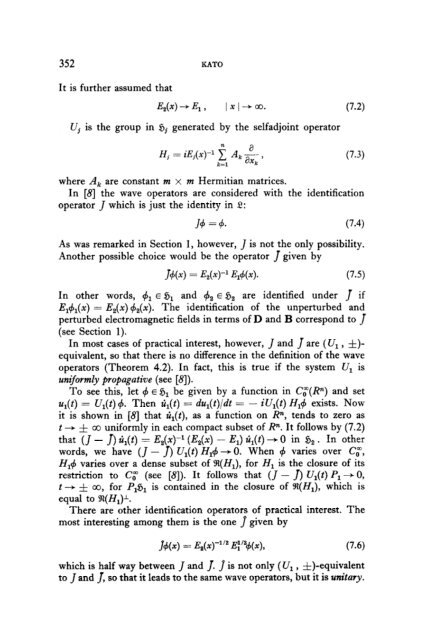On the Characters and the Plancherel Formula of Nilpotent Groups ...
On the Characters and the Plancherel Formula of Nilpotent Groups ...
On the Characters and the Plancherel Formula of Nilpotent Groups ...
Create successful ePaper yourself
Turn your PDF publications into a flip-book with our unique Google optimized e-Paper software.
352 KATO<br />
It is fur<strong>the</strong>r assumed that<br />
J%(x) -+ 4 3 IxI+m. (7.2)<br />
Uj is <strong>the</strong> group in Bj generated by <strong>the</strong> selfadjoint operator<br />
Hj = iE,(x)-1 i A, $- ,<br />
k=l<br />
k<br />
where A, are constant m x m Hermitian matrices.<br />
In [S] <strong>the</strong> wave operators are considered with <strong>the</strong> identification<br />
operator J which is just <strong>the</strong> identity in 2:<br />
14 =h (7.4)<br />
As was remarked in Section 1, however, J is not <strong>the</strong> only possibility.<br />
Ano<strong>the</strong>r possible choice would be <strong>the</strong> operator J given by<br />
(7.5)<br />
In o<strong>the</strong>r words, $1 E sj, <strong>and</strong> 4s E 8s are identified under J if<br />
E,+,(x) = E,(x) r&(x). The identification <strong>of</strong> <strong>the</strong> unperturbed <strong>and</strong><br />
perturbed electromagnetic fields in terms <strong>of</strong> D <strong>and</strong> B correspond to J<br />
(see Section 1).<br />
In most cases <strong>of</strong> practical interest, however, J <strong>and</strong> J are (U, , -J-)-<br />
equivalent, so that <strong>the</strong>re is no difference in <strong>the</strong> definition <strong>of</strong> <strong>the</strong> wave<br />
operators (Theorem 4.2). In fact, this is true if <strong>the</strong> system U, is<br />
uniformi’y propagative (see [S]).<br />
To see this, let 4 E sj, be given by a function in C;(P) <strong>and</strong> set<br />
z+(t) = U&)+. Th en z&(t) = du,(t)/dt = - iU,(t) HI+ exists. Now<br />
it is shown in [S] that zir(t), as a function on Rn, tends to zero as<br />
t --+ * co uniformly in each compact subset <strong>of</strong> P. It follows by (7.2)<br />
that (J - J) &r(t) = E,(x)-r (E,(X) - EJ r&(t) + 0 in s, . In o<strong>the</strong>r<br />
words, we have (J - J) Ul(t) Hr+ -P 0. When 4 varies over Cc,<br />
Hi+ varies over a dense subset <strong>of</strong> %(H,), for Hr is <strong>the</strong> closure <strong>of</strong> its<br />
restriction to C; (see [8]). It follows that (J - J) Ul(t) PI -+ 0,<br />
t -+ & co, for P,fi, is contained in <strong>the</strong> closure <strong>of</strong> %(H,), which is<br />
equal to %(H,)l.<br />
There are o<strong>the</strong>r identification operators <strong>of</strong> practical interest. The<br />
most interesting among <strong>the</strong>m is <strong>the</strong> one p given by<br />
&x) = E&)-1’2 E;“#(x), (7.6)<br />
which is half way between J <strong>and</strong> 1. f is not only (U, , -&)-equivalent<br />
to J <strong>and</strong> J, so that it leads to <strong>the</strong> same wave operators, but it is zmitary.

















